Dips with Weight Belt [Complete Guide]
![Dips with Weight Belt [Complete Guide]](https://blog.aqfsports.com/wp-content/uploads/2023/07/image7-3.jpg)
Are you feeling stuck in your upper body workouts lately? I get it, and we’ve all been there. You put in the hard work, but the progress sometimes seems to plateau. Well, guess what? We have a solution to pump up your workout: Dips with a weight belt!
We’re talking about adding weights to your dips and getting some serious gains! Trust me; it’s a game-changer you won’t want to miss.
You know, building upper body, core, and back muscles is tough. But with the right approach and a weight belt, a sculpted chest and powerful triceps are well within your reach.
In this ultimate guide, we will share pro dipping techniques along with common mistakes to avoid. We will also cover:
- Method to wear a dip belt.
- How to do dips with a belt.
- What to look for in a dip belt.
By the end of this read, you will feel more confident using a dip belt.
So, let’s get straight to the point!
What is a Dip Belt?
A dip belt is a specialized piece of equipment that adds extra resistance or weight to certain exercises, specifically dips. It’s like a superhero utility belt for your dips with weights!
Here’s how a dip belt works: A dip belt consists of a sturdy strap that goes around your waist, just like a regular belt. What makes it different is the additional chain with attachment points where you can hook on weight plates, dumbbells, or kettlebells.

When you’re all geared up, you can perform dips with additional weight, which makes your exercise more challenging and effective. This added resistance forces your muscles to work harder. It helps you build more strength and bulk up your chest, shoulders, and triceps muscles.
Dipping belts are incredibly versatile too! Besides dips, you can use them for other exercises like pull-ups or chin-ups to take your training to the next level.
So, the next time you see someone at the gym strapping on a belt with weights dangling, you know they’re rocking a dip belt!
How to Do Dips with a Weight Belt?
Here’s my step-by-step guide on how to do weighted dips like a champ with your weight belt:
Step 1: Wear the Belt:
Securely fasten your weight belt around your waist. Ensure it’s snug but not too tight, allowing you to move comfortably.
Step 2: Load Up The Weight:
Attach the desired weight to the chain or hooks of the weight belt. Go for weight plates, dumbbells, or kettlebells.
Choose what challenges you without compromising your form.
Step 3: Get in Proper Dip Position:
Position yourself at a dip station or parallel bars. Grip the bars firmly with your palms facing down. Lift your body off the ground, keeping your arms straight.
Step 4: Control Your Descent:
Engage your core. Bend your elbows and slowly lower your body. Control your body’s descent and keep lowering your body until your shoulders are slightly below your elbows.
Step 5: Power Upward:
Push through your palms with force and straighten your arms to lift your body back up. Exhale as you push back up to the starting position.
Step 6: Rep It Out:
Now that you’ve got the rhythm, repeat the movement for the desired number of reps. Focus on your form throughout.
Step 7: Add More Loads Mindfully:
Carefully remove the weight belt after completing your set.
You can add more load once your body adjusts to the old regimen.
Step 8: Stretch and Recover:
After your weighted dips session, relax and give your muscles time to cover. Stretch your chest, triceps, and shoulders to aid in recovery and maintain flexibility.
Which Muscles Do Dips with Weights Target In Your Body?
Upper Body Muscles:
Chest Muscles (Pectoral Muscles):
These bad boys make up the front of your chest. When you do dips, they’re responsible for pushing your arms.
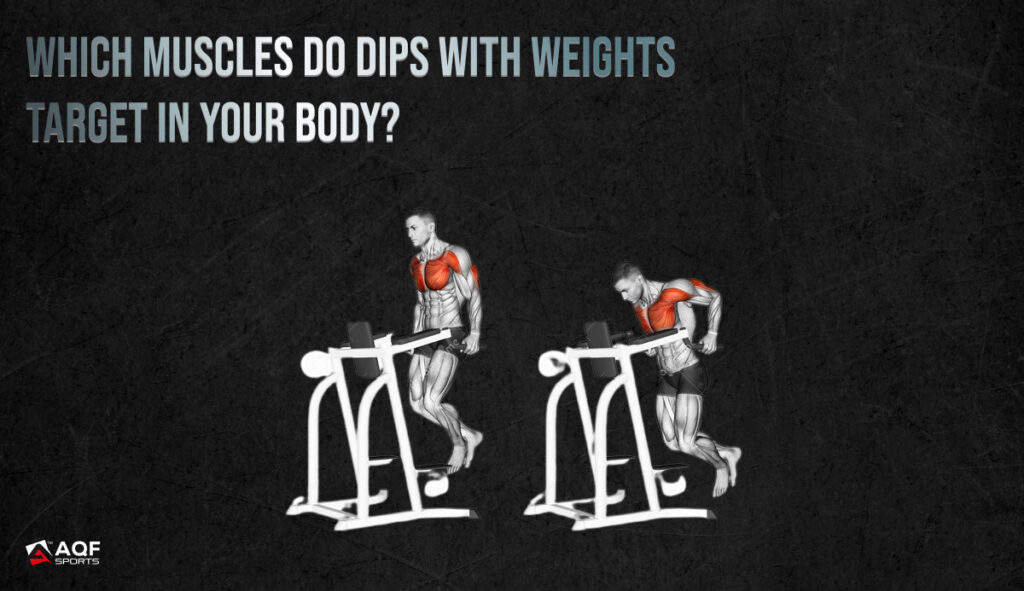
Shoulder Muscles (Deltoid Muscles):
Delts are on your shoulders. During dips, these muscles stabilize your arms as you lower and push up your body.
Triceps (Triceps Brachii):
Triceps are located at the back of your arms. These muscles straighten your elbow and lift your body during a dip.
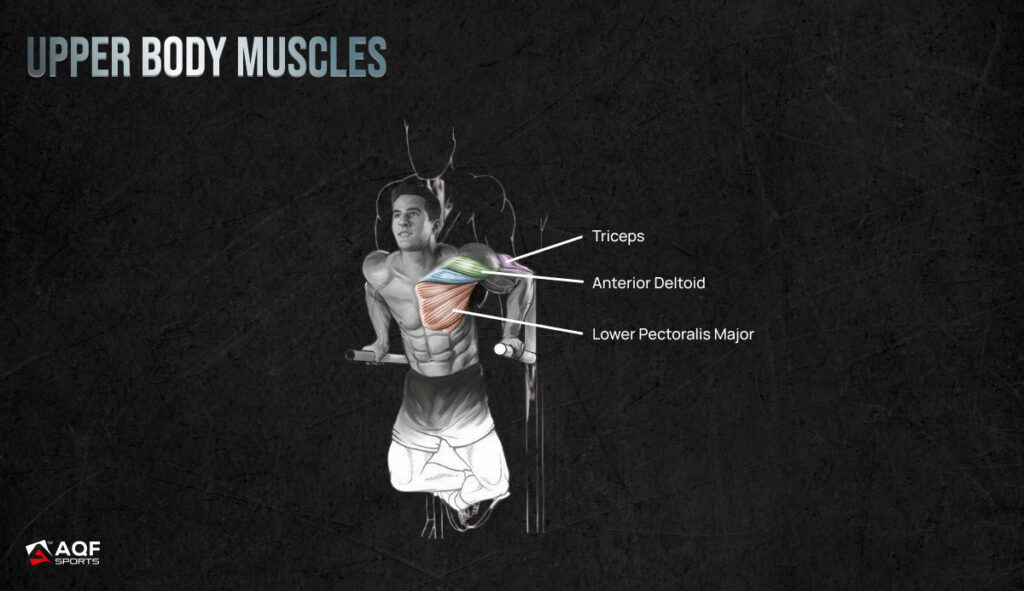
Upper Back Muscles:
- Rhomboids: These are found between your shoulder blades and keep them steady during dips. They protect your shoulder blades.
- Lower Trapezius: Found in the upper back, these muscles stabilize your shoulder blades.
Serratus Anterior:
These muscles are on the sides of your chest and have a special role during dips. They help move your shoulder blades forward and give you that extra push as you rise back up.
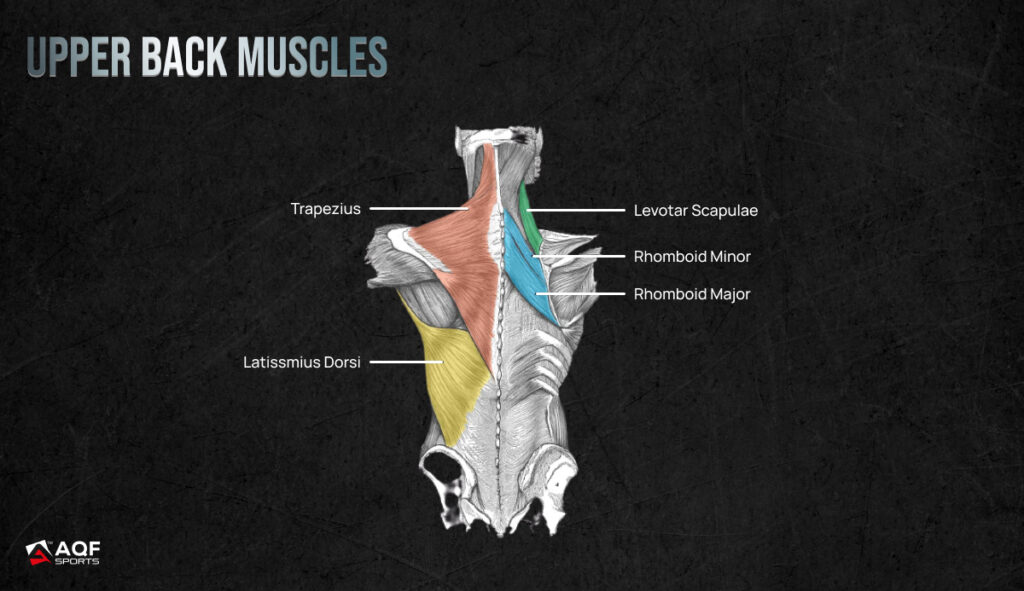
Core Muscles:
Rectus Abdominis:
Say hello to your six-pack muscles! These muscles are located in front of your belly. When you do dips, they stabilize and control your torso.
Obliques:
The obliques are on the sides of your belly and help with core stability during dips.
Benefits of Doing Dips with a Weight Belt
Let’s discuss why a dip belt is an absolute game-changer for your workouts!
Compound Exercise
Dips are a compound exercise that targets multiple muscle groups simultaneously. This compound movement engages your chest, shoulders, and triceps in a coordinated effort, resulting in optimal muscle activation and growth. [1]
Hulk-Like Strength Gains
During dips, your muscles contract and generate force to lift your body weight or the added weight when using a dip belt. This repeated resistance and load on the muscles lead to microscopic tears in the muscle fibres. [2]
As your body repairs these tears, the muscle fibres grow stronger and thicker, increasing muscle strength and size.
Suggested Read: Strength Training 101 | The Ultimate Guide to Get Started
Bone Tissues Get Stronger
Weight-bearing exercises like dips stress your bones, prompting your body to adapt and strengthen the bone tissue to handle the increased load.
This process, called bone remodelling, involves bone cells breaking down old bone tissue and replacing it with new, stronger bone material. [3]
Over time, it improves bone density making them more resilient to osteoporosis.
Joint Health Improves:
Contrary to the misconception that dips may harm your joints, they improve joint health when performed with proper technique.
Dips strengthen the connective tissues in your shoulders, chest, and elbows as you use your full range of motion. This, in turn, enhances joint stability and resilience.

Body Balance and Stability:
You must maintain upper body stability when lowering and pushing up your body during dips with weights. During this process, your body engages the stabilizer muscles in your shoulders, upper back, and core to improve overall stability and control during the movement.
Strong stabilizer muscles prevent injuries and maintain proper form in various other exercises and daily activities.

Multi-Purpose Versatility
A weighted dip belt is a highly versatile piece of equipment. Its primary purpose is to add extra weight to dips, but it can also be used for other exercises.
You can perform weighted pull-ups, chin-ups, and even squats by attaching weight plates or dumbbells to the dip belt. This versatility allows you to target different muscle groups and create a more varied and challenging workout routine.
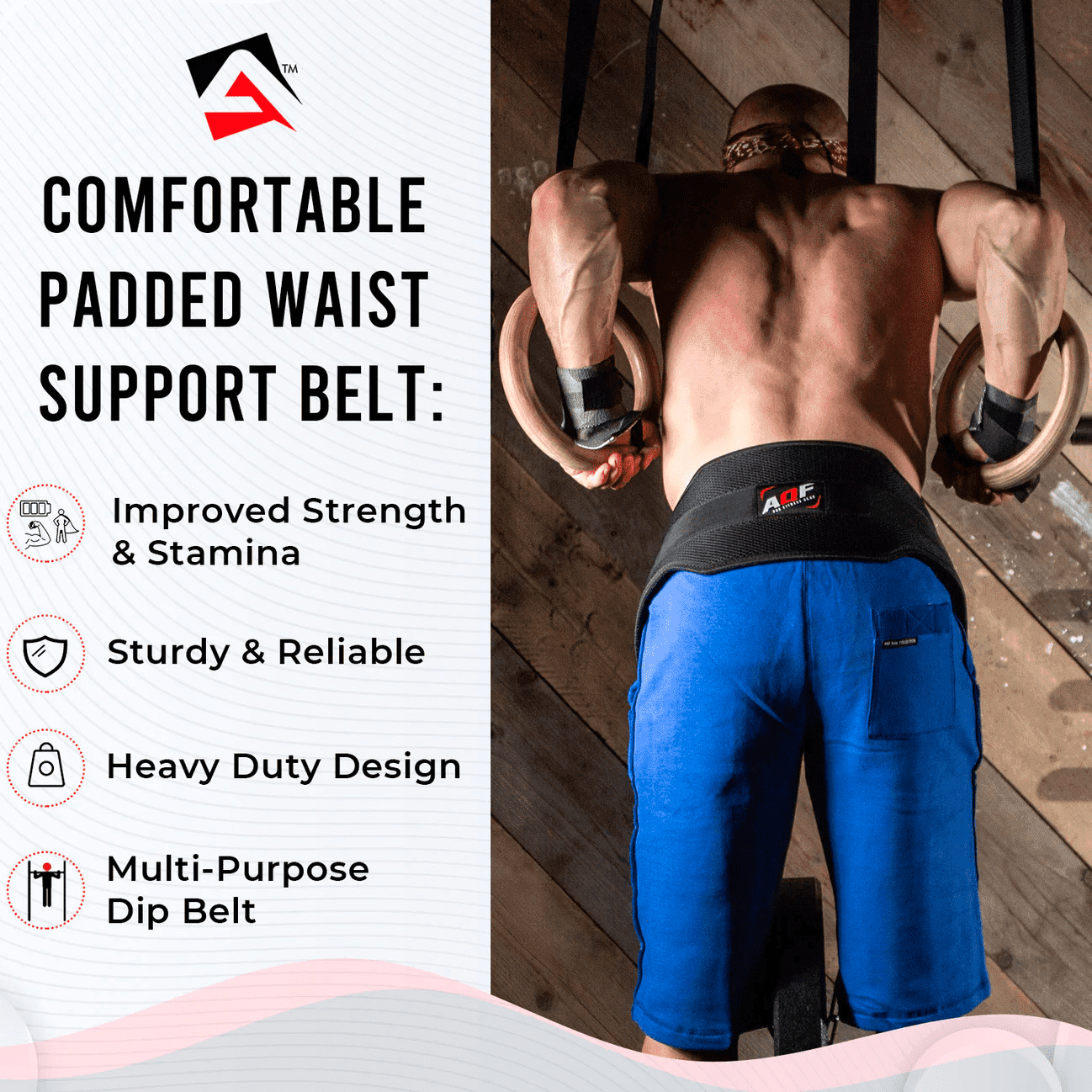
How to Wear a Weight Belt for Dips: A Step-by-Step Guide
Here are the steps you need to follow to wear a weight belt for dips:
Step 1: Wrap The Belt Around Your Waist
Start by strapping the weight belt around your waist. The chain and loops should be before you, not behind your back. If the belt has extra padding, centre it on your back for more comfort.
Step 2: Thread the Chain Through The Loops
Now, take the chain, and pass it through the loops. Pull the chain until it feels snug but not too tight. You don’t want it digging into your skin.
Step 3: Pick Your Weight
Time to get serious! Grab the weight you want to use and attach it to the chain. You can put the chain through any of its holes if it’s a flat plate.
Step 4: Remove Slack from the Chain
Before you start dipping, ensure there’s no slack in the chain. Pull the chain and remove any stretch. The weight should not be hanging too low, touching the ground, or too high, interfering with your movement.
Step 5: Lock It In Place using the D-Ring
Secure the chain with a clasp or carabiner. Double-check that it’s firmly in place before you start your workout.

Step 6: Start Your Exercise!
You are all set! Get into your regular dip position and ensure the weight isn’t hitting the ground or causing discomfort. Time to rock those dips with some added intensity!
Common Mistakes To Avoid When Doing Dips with Weight Belt
Mistake 1: Your Dips Look and Feel Wonky
So, when you first put on that weight belt and add some extra pounds, you might notice your dip movements are not the same.
Don’t stress! It’s totally normal. The added weight messes with your usual dip mechanics, and your body uses different muscles to stay balanced.
Solution: Take it slow and steady. Load up with less weight initially, and give yourself some time to adjust. Once you’ve got the hang of it, you can crank up the load and rock more intense dips!
Mistake 2: You Are Dragging the Chain As You Go
Uh-oh, is your chain too long? It will be trouble if it’s dragging on the floor while you dip. When the weight hits the ground, the party’s over! You will not be getting the full benefits of the added load.
Solution: Shorten the chain. Keep the weight off the ground, and you’ll feel the burn where it counts.
Mistake 3: You Did Not Clip the Weight Securely
Safety First, folks!
Forgetting to clip the chain to the belt is a hilarious (not really) disaster.
All that weight crashing on the floor might hit your shins and ankles—ouch!
Solution: Double-check that you’ve securely clipped the chain to the belt. Safety is good, and you want your dips to be smooth and pain-free.
Mistake 4: Your Belt is Placed Too High or Too Low
Is your belt going solo during dips? If you cinch the belt too high, it will mess up your balance. If the belt is too low, it’ll drag everything down, and you cannot pull yourself back up.
Solution: Position the belt around your waist – not too high or not too low. Find that sweet spot for stability, and you’ll dip like a champ!
Mistake 5: Your Weight Load is Not Balanced
Improperly loading weight on the chain leads to imbalanced movements. It is mainly because you have more weight on one side than the other. As a result, the side of your body with more weight is under more strain causing imbalance movements.
Solution: Always double-check that the weight is evenly distributed on both sides of the chain for a balanced dip session.
Mistake 6: You Are Using a Loose Chain
Lose, or poorly secured chain can be hazardous. It might slip off during your dips, and you may lose weight control.
Solution: Ensure the chain is securely fastened and not too loose to prevent any mishaps.
Mistake 7: You Are Arching Your Back Too Much
Some people tend to arch their back excessively during weighted dips, which strains the lower back and compromises the exercise’s effectiveness.
Solution: Keep your back straight and avoid excessive arching. Engage your core and maintain a levelled spine throughout the dip.
Mistake 8: You Are Swinging Too Much
Excessive swinging during dips takes your focus away from your targeted muscles and reduces the exercise’s effectiveness.
Solution: Maintain a smooth and steady motion while performing controlled dips. Avoid swinging or jerking movements.
Mistake 9: You Are Not Engaging Your Core Muscles
Partial or incomplete dips won’t give you the full benefits of the exercise. It’s crucial to engage your core muscles fully to feel the burn.
Solution: Lower your body until your shoulders reach below your elbows, and then push back up to the starting position.
Mistake 10: You Are Using Too Much Weight for Repetitions
Trying to lift an extremely heavy weight for high repetitions causes fatigue and compromises your form. You may end up injuring yourself.
Solution: Choose an appropriate weight to perform the desired number of sets with proper form and control.
Should You Use a Regular Lifting Belt for Dips with Weights?
Short answer: Yes, you can.
Although not recommended, you can use a regular lifting belt for dips with weights. There are two methods to do this:
The Chain Method:
If you have a standard single prong or lever belt and a chain with a clasp, you’re good to go. Simply wind the chain through the front of the belt to create the loop needed to add weights.
Once you cinch the weight lifting belt to your usual width, it’ll snugly fit around your frame, allowing the chain to swing freely. Cool, right?
Here is the downside: You must visit a local hardware store to purchase and cut the chain to the right length. You might face difficulty customizing the belt length for different exercises if you don’t cut enough chains. A bit of trial and error might be involved.
The Band Method:
Don’t have a chain? No worries, you can still make it work. Use a band looped over your belt and fasten it to the floor with a heavy dumbbell or another immovable object.
The band will provide resistance during the lifting phase of the dip, making it a makeshift weight belt.
Here is the deal:
This method should be your last resort. Why? Well, it’s not the most comfortable setup, requires time to set up before each dip, and can make your movements jerky and unstable. Not the ideal way to get those gains, right?
More Ways to Do Dips with Weights [Other Than Using a Dip Belt]
Weight Plate Between Legs:
Hold a weight plate between your legs using your feet and ankles while performing dips. This method can be effective for adding resistance without additional equipment.
Dumbbell or Kettlebell Between Legs:
Hold a dumbbell or kettlebell securely between your legs during dips. Grip it firmly between your legs to prevent slipping.
Use a Chain or Resistance Band:
Attach a chain or resistance band to a dipping belt or waist belt, then attach the weight to the chain or band using carabiners. This setup can mimic the functionality of a dip belt.
Weighted Vest:
Wear a weighted vest during dips to add resistance to the exercise. Weighted vests are designed specifically for this purpose and provide a comfortable and safe way to add load.
Word of Caution!
DIY Methods for doing dips with weights are not as safe as using the dip belt. Trainers recommend using the appropriate equipment for dips for your safety.
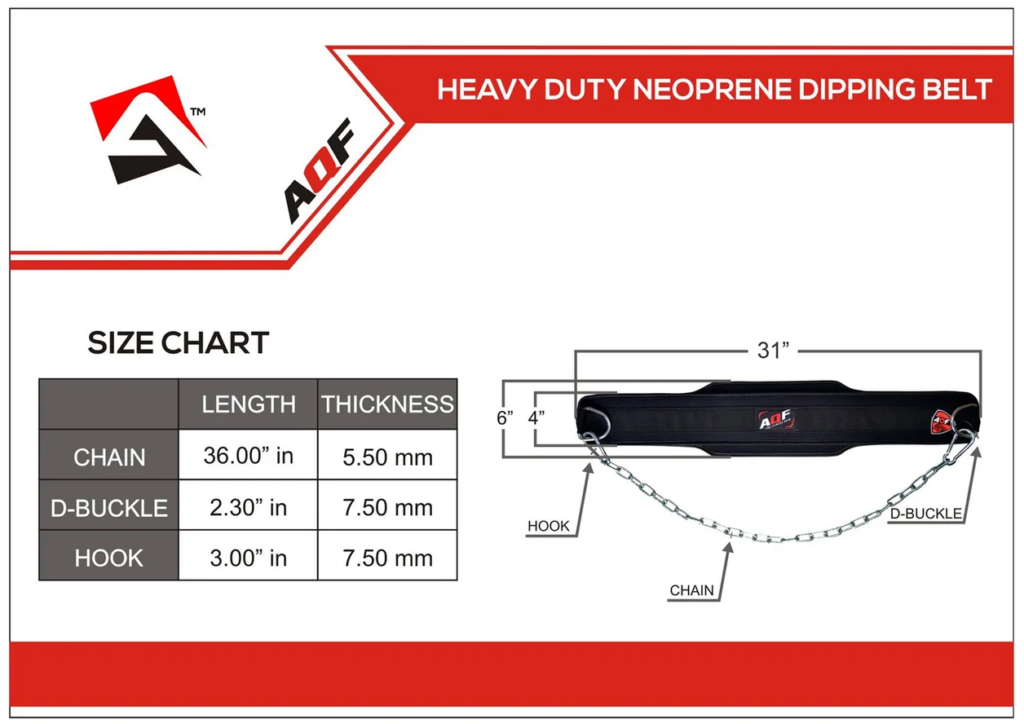
Advanced Dip with Weight Belt Variations
Do you dare level up your workout? Here are some advanced dip variations:
Weighted Parallel Bar Dips:
- Strap on your weight belt securely.
- Find a set of sturdy parallel bars.
- Grip the bars with your hands shoulder-width apart.
- Lower your body by bending your elbows until your upper arms parallel the ground.
- Push yourself back up to the starting position.
- Repeat for the desired number of reps.
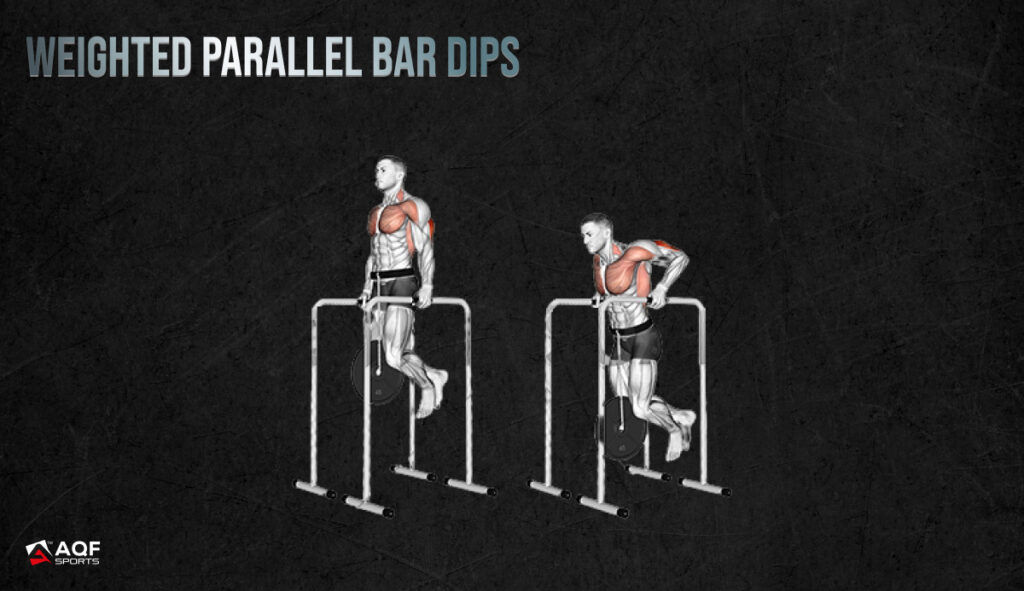
Benefits:
- Targets chest, shoulders, and triceps
- Adds resistance to traditional dips for muscle building.
- Boosts pushing power and athletic performance.
Weighted Ring Dips:
- Attach the weight belt securely around your waist.
- Grip the rings with your hands and extend your arms fully.
- Lower your body by bending your elbows until your shoulders are below your elbows.
- Push yourself back to the starting position, keeping the rings stable.
- Repeat for the desired number of reps.

Benefits:
- Improves stability and balance.
- Engages core and stabilizer muscles.
- Builds functional strength for sports and daily activities.
Weighted L-Sit Dips:
- Securely fasten the weight belt.
- Position yourself on the parallel bars with your hands gripping the bars.
- Lift your legs straight out before you, forming an L-shape with your body.
- Lower your body by bending your elbows.
- Push back up while maintaining the L-sit position.
- Repeat for the desired number of reps.

Benefits:
- Challenges core muscles
- Targets triceps and shoulders.
- Boosts body control and coordination.
Weighted Muscle-Ups:
- Attach the weight belt.
- Begin with a strong grip on the rings or bar.
- Perform a controlled pull-up, pulling your body towards the rings or bar.
- As you reach the top, transition into a dip position, lowering yourself down.
- Push yourself back up to the starting position.
- Repeat the sequence for the desired number of reps.
Benefits:
- Challenging full-body workout.
- Builds upper body strength and power.
- Enhances coordination and upper body mobility.
Weighted Dip Holds:
- Put on the weight belt securely.
- Perform a regular dip and lower yourself to the bottom position.
- Hold the bottom position for a set time (e.g., 10-20 seconds).
- Push yourself back up to the starting position.
- Repeat the hold for the desired number of sets.

Benefits:
- Develops isometric strength
- Improves muscle endurance and control
- Reinforces mind-muscle connection
What To Look For in a Weight Belt for Dips?
If you’re hunting for a weighted belt for dips, I’ve got your back with some awesome tips! Here’s what you should look for:
First, let’s talk about the material. Want that classic sturdy feel? Go for a genuine leather belt. Need some flexibility and cushioning? Neoprene belts are the best option. And if you want to stay cool during dips, look for belts with nylon or mesh panels.
-
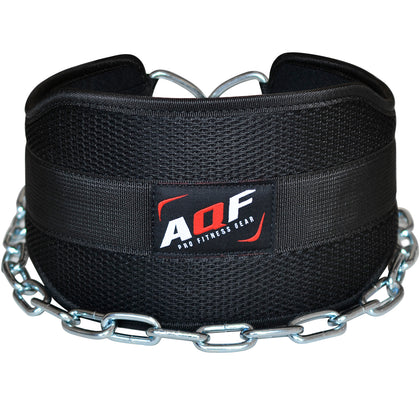
AQF Dipping Belt with Chain
View Details -
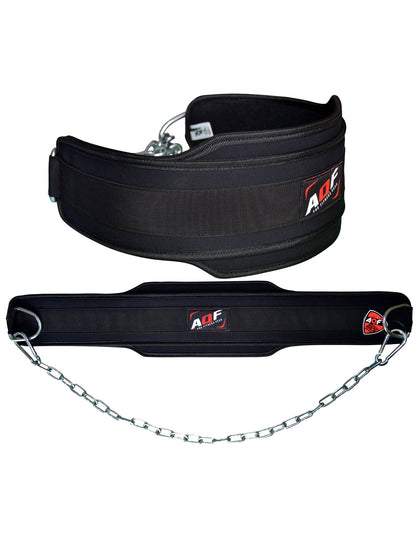
AQF Heavy Duty Dipping Belt with Metal Chain
View Details -
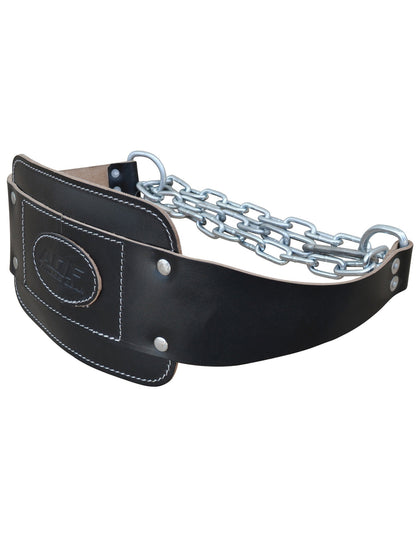
AQF Leather Dipping Belt Padded with Chain
View Details
Padding:
Go for a belt with thick padding, especially in the back. It’ll give you that extra back support and evenly distribute the pressure when dipping with heavyweights.
Breathability:
Nobody likes a sweaty back, right? Look for belts with mesh or ventilated designs to keep you cool and dry during intense dips.
Stitching:
We want that belt to last, don’t we? Make sure it’s got some quality stitching. Trust us; you don’t want your belt falling apart when you’re giving it your all.
Easy to Fasten:
A belt that’s easy to put on and take off is a game-changer. Look for strong D-rings, sturdy buckles, or reliable Velcro straps for a secure, hassle-free fit.

Wide is Nice:
Go for a wider belt to perform dips with stability. Pick the one that covers the most of your back and will keep you steady to prevent any unsafe moves.
Fit and Adjustability:
You have to get the right fit! Choose a belt that matches your waist size and offers an adjustable chain.

Load Handling:
You wanna challenge yourself, right? Pick a belt that can handle the maximum weight you plan to add.
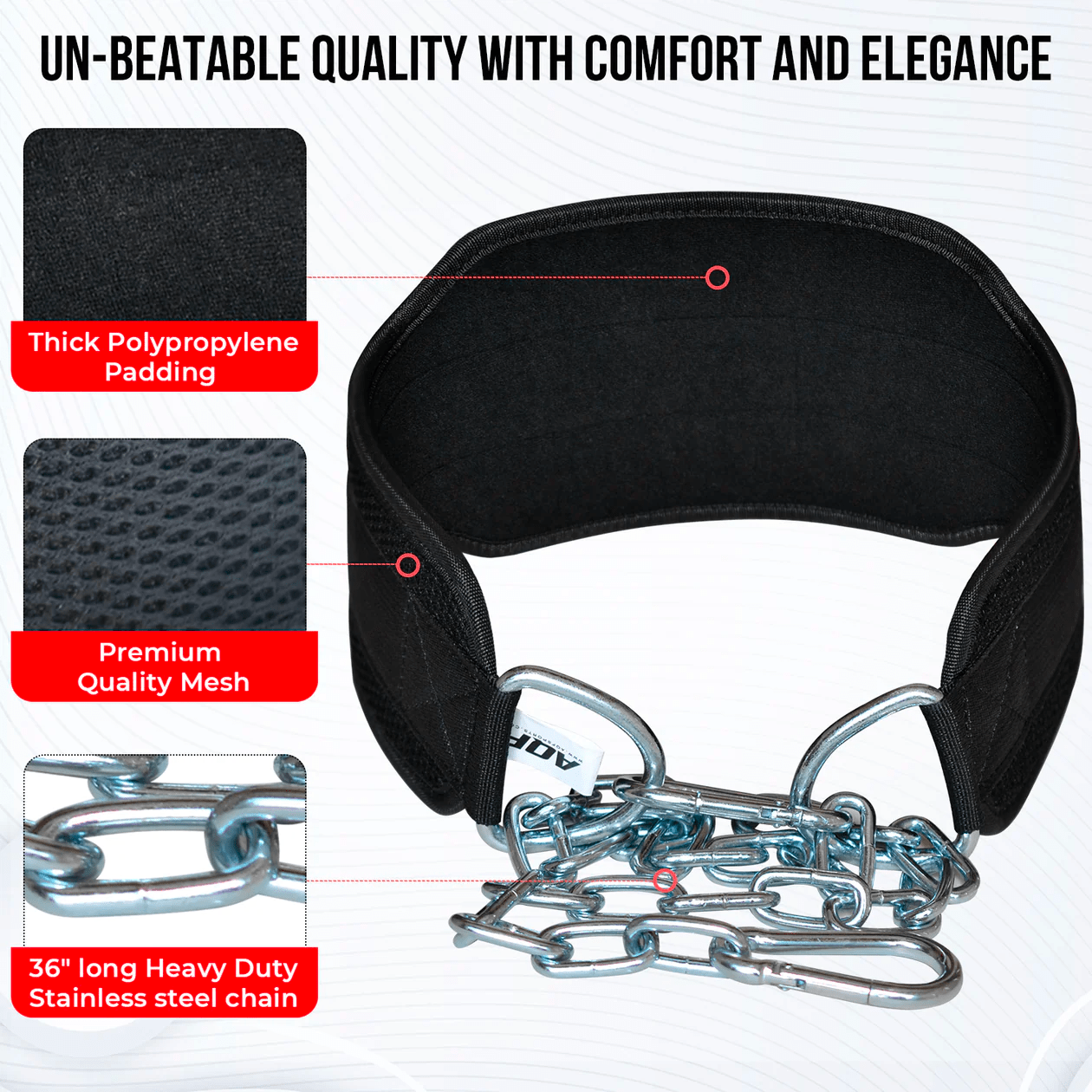
In a Nutshell…
Adding weights to your dips is a game-changer! Whether a newbie or a gym pro, a weight belt takes your upper body dips to the next level.
Use a weight belt for dips to engage your chest, shoulders, triceps, and core like never before. Dips with weight belts are super versatile, so you can adjust the difficulty level to suit your fitness level. Plus, they promote muscle building, joint health, and functional strength.
Focus on proper form and gradually increase the weight to build your triceps, strengthen your back, and sculpt your chest like a pro!
Dips with a weight belt will not be easy, but are you up for the challenge? Let’s go! 🏋️♂️💪
Here are a few more must-reads from our blog,
- Leather vs Nylon Lifting Belt! How to Choose the Right One?
- The Definitive Belts Guide: Powerlifting vs Weightlifting Belt?
- Common Weightlifting Belt Mistakes You Must Avoid
References:
[1] McKenzie, A., Crowley-McHattan, Z., Meir, R., Whitting, J., & Volschenk, W. (2022). Bench, Bar, and Ring Dips: Do Kinematics and Muscle Activity Differ? International Journal of Environmental Research and Public Health, 19(20), 13211. https://doi.org/10.3390/ijerph192013211
[2] Symptoms and Signs of Muscle Strain: Treatment. (n.d.). EMedicineHealth. Retrieved July 26, 2023, from https://www.emedicinehealth.com/muscle_strain/symptom.htm
[3] Hill, P. A. (1998). Bone remodelling. British journal of orthodontics, 25(2), 101-107.





